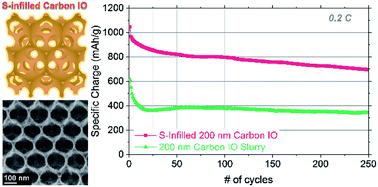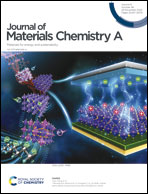The importance of sulfur host structural preservation for lithium–sulfur battery performance†
Abstract
The identification of sulfur host materials, which can overcome issues associated with the insulating nature of sulfur and the shuttling of soluble lithium polysulfides, is crucial in order to realize the practical applications of lithium–sulfur (Li–S) batteries. Therefore, the development of conductive electrode architectures with novel, porous structures is essential to improve the electrochemical performance of Li–S cells. To this end, carbon inverse opals (IOs) were prepared using sacrificial polystyrene spheres, directly on a current-collecting substrate, and were infilled with sulfur via a solution infiltration method. The electrochemical performance of S-infilled carbon IOs (S-CIO), prepared with spheres of different diameters, is evaluated through cyclic voltammetry and galvanostatic cycling. We demonstrate that S-CIO provide long cycle life and stable specific charge, when tested as cathode materials for Li–S batteries. IO samples, prepared with smaller spheres (100 and 200 nm diameters), achieve significantly higher specific charge values than samples prepared with larger spheres. The electrochemical performance of our S-CIO is compared with conventional slurry electrodes containing CIO powder. Mechanical stress during slurry preparation, grinding or ball-milling of material, destroys the IO structure, resulting in worse electrochemical performance as compared to as deposited IO samples. Consequently, this report offers insight into the importance of retaining and optimizing the structure of conductive S-hosts for improving electrochemical performance of Li–S cells.



 Please wait while we load your content...
Please wait while we load your content...